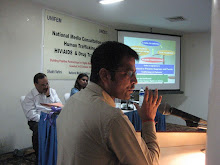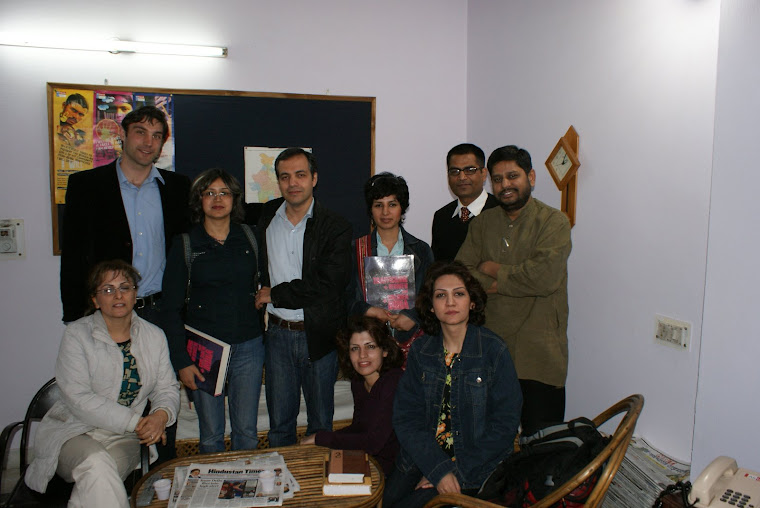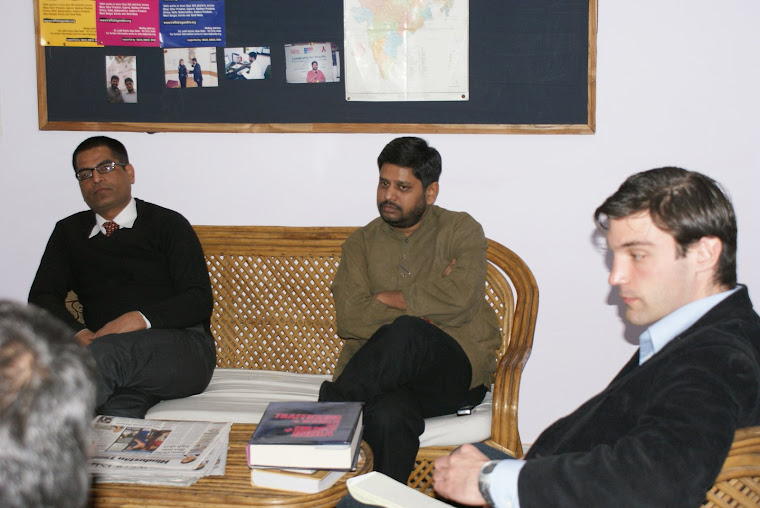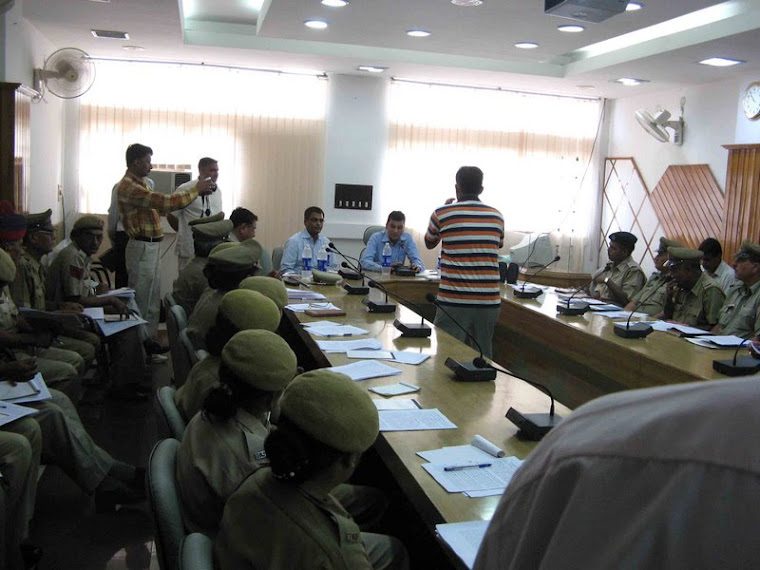REVISEDITEM NO.38 COURT NO.7 SECTION PIL SUPREME COURT OF INDIA RECORD OF PROCEEDINGS WRIT PETITION (CIVIL) NO(s). 266 OF 2009RAVI KANT & ANR. Petitioner(s) VERSUSSTATE OF U.P. & ORS. Respondent(s)(With appln(s) for exemption from filing O.T.)Date: 29/06/2009 This Petition was called on for hearing today.CORAM : HON'BLE MR. JUSTICE DALVEER BHANDARI HON'BLE MR. JUSTICE ASOK KUMAR GANGULY [VACATION BENCH]For Petitioner(s) Mr. Ravi Kant, Adv. Mr. Sukumar, Adv. For Respondent(s) Mr. U.U. Lalit, Sr. Adv. Mr. Satish Chandra Mishra, Sr. Adv. Mr. Jyotinder Mishra, Sr.Adv. Mr. Pramod Swarup, Sr. Adv. Mr. S.K. Dwivedi, Adv. for Mr. G.V. Rao, Adv. UPON hearing counsel the Court made the following ORDER
Two public spirited persons who are practicing advocates have filed this writ petition in which the grievance has been made that hundreds of crores of public money is being spent by the Government of Uttar Pradesh for personal glorification by erecting statues particularly of leaders who are presently in power. It is also incorporated in the petition that 2the installation of sixty elephants' statue at the cost of RS. 52.20crores is not only wastage of public money but also contrary tothe circulars issued by the Election Commission. It is alleged that the Uttar Pradesh Department ofCulture has almost spent 90% of its budget for erecting thesestatues. In the petition, a reference has been made to thecommunication sent by the Election Commission of India on1.4.2009. The relevant portion of the communication reads asunder: "The underlying intention of the Commission's instruction was that the photographs and images of the political functionaries, who have deep influence on the minds of electors and many of whom are still active in public life and may even be contesting the current general elections, should not be displayed in the government buildings and premises as that would have the effect of disturbing the level playing field vis- a-vis the political functionaries of other parties and candidates. In view of the inputs received, the Commission had issued the above instructions. In the meanwhile, certain doubts have been raised and clarification has been sought about the removal of the images of some national leaders, poets and prominent historical personalities of the past. In this regard, the Commission would like to state that the above mentioned underlying purpose of the instruction needs to be fully appreciated while being acted upon. It is clarified that while the photographs of Prime Minister, Chief Ministers, Ministers and other 3 political functionaries should not be displayed, this instruction, however, is not applicable with regard to the images of national leaders, poets and prominent historical personalities of the past, and the President of India and the Governors. It is further clarified that in case of any doubt in this regard regarding removal of any photograph or images, the issue may be referred to the Chief Electoral Officer of the State/ Union Territory concerned before taking action in the matter." In the petition, it is also mentioned that in the State ofU.P., human development index is among the lowest in thecountry. It is further stated that: 1) U.P. has the lowest literacy rate in the country 56.27% (68.82 male and 42.22 females -2001 census) 2) U.P. tops in India on maternal mortality. 3) In neo natal mortality U.P. is among the top five states. 4) U.P. has the highest number of child labour as per 2001 census. 5) U.P. had the largest number of poor with 59 million living below the poverty line. 6) Out of 97122 villages, 56977 villages are electrified (59%) as per CEA data of 2005. In the petition, it is stated that the State of U.P. needsmore funds for the emancipation of socio economic problems. Itis also stated that it is the duty and obligation of the State tomake policy and programmes for the welfare of the public at 4large and especially for the weaker sections of the society. Thepetitioners would perhaps have no objection if there would havebeen one or two symbolic statues for drawing inspiration in theState. The huge public funds which are otherwise meant forimproving the conditions of millions of people living below thepoverty line cannot be legitimately diverted for erecting statuesand parks. The State must properly set its priorities. Theconcerned authorities in power must realize that they areholding public money in trust and it must be judiciously spent. In the petition, it is alleged that the respondents haveshown utter disregard to the constitutional mandate whiledeciding to spent huge money on installing a very large numberof statues. According to the petitioners, the funds need to beused for the welfare and development of people and particularlyof the weaker sections of the society. Notice to show cause as to why this petition be notadmitted. Mr. G.V. Rao, advocate accepts notice on behalf ofrespondent Nos. 1 & 2. He prays for and is granted four weeks'time to file counter-affidavit. Notice be sent to the remainingrespondents. (Pardeep Kumar) (Neeru Bala Vij) Court Master Court Master
Tuesday, June 30, 2009
Why the fetish for statues? SC asks Mayawati government
Why the fetish for statues? SC asks Mayawati government
30 Jun 2009, 0106 hrs IST, Dhananjay Mahapatra, TNN
NEW DELHI: In what could trip UP chief minister Mayawati's plans to construct grandiose stone images of herself, BSP founder Kanshi Ram and Dalit
icon B R Ambedkar, the Supreme Court on Monday sought a response from the leader on a PIL alleging a massive waste of public money. The Supreme Court has indicated that it might have some tough questions for the Mayawati government even as the BSP leader's aide Satish Mishra, who also pleaded her case in court, hit back claiming that monuments and memorials to upper caste leaders never seemed to generate the same concern and outrage. The BSP argued that the developmental work of the Mayawati government never attracted any attention while the monuments were selectively highlighted. The BSP's accusation of a political agenda and bias did not deter the SC from asking for some responses while it explained that it was not passing any sort of interim order. With the PIL arguing that public funds could be better utilised to help UP's poor, the SC seemed to pose a "Why the fetish for your own statues" query for the Mayawati government with a Bench comprising Justices Dalveer Bhandari and A K Ganguly quoting from the petition filed by PIL by advocates Ravi Kant and Sukumar. The PIL alleges that spending over Rs 1,200 crore on statues was irresponsible when UP had the largest population -- 59 million -- of people below the poverty line. Not surprisingly, the SC notices left the Mayawati government bristling. Appearing for the state, Mishra tried to convince the Bench that the PIL was politically motivated. He even objected to a large portion of the petitioner's allegations being quoted in the order. When the Bench appeared unimpressed, Mishra gave vent to the anguish of the Mayawati government and said memorials for other leaders seldom raised an eyebrow, except when they were meant for a Dalit icon. He sought to buttress his argument by citing the example of the sprawling Teen Murti Bhawan in Delhi, which is a memorial for the first Prime Minister Jawaharlal Nehru. "We would like the court also to focus on larger issues like Teen Murti Bhawan which at present would be worth more than Rs 3,000 crore. It hurts when no one questions such memorials. But, if a memorial for Dr Ambedkar is built, then objections are raised," he said after the court issued notices. Earlier, senior advocate U U Lalit said the PIL petitioners had no connection with UP and that all the expenditure on the statues and renovation of parks had been duly sanctioned by the assembly and that nothing was being done without proper sanction. When the court said it has not issued any interim order but was merely seeking response of the state government, Mishra said: "We will bring all the larger issues before the court and it should deal with them." Given the tone and tenor of the arguments, the Mayawati government is sure to list out the number of memorials for upper caste leaders and draw a contrast with the smaller numbers dedicated to Dalit leaders. Mishra also told TOI that huge amounts were being spent by the Mayawati government for the upliftment of the poor, building schools and hospitals besides social upliftment schemes for oppressed class. "The media highlights only the memorials built to honour Dalit leaders and ignores the developmental work of the Mayawati government," he said. Petitioner Ravi Kant, who collated information using the RTI provisions, told the court how massive money was spent on erecting statues of Mayawati and Kanshi Ram in various parks of Lucknow -- Dr Bhim Rao Ambedkar Samajik Parivartan Sthal, Manyawar Kanshi Ram Memorial at Alambag, Kanshi Ram Bahujan Nayak Park, Ramabai Ambedkar Rally Maidan, Kanshiram Sanskritik Sthal, Dr Ambedkar Samajik Parivartan Prateek Sthal, Manywar Kanshiram Yaadgar Vishram Sthal, Buddha Sthal, Eco Park, Samata Mulak Churaha and Dr Ambedkar Chauraha, Buddha Shanti Upwan and Prerna Sthal. The petition said all these extravagance was happening when UP had the dubious distinction of having the lowest literacty rate of 56.27%, the highest maternal and neo-natal mortality rate, largest child labour force, largest number of people living below the poverty line and only 59% of villages (56,977 of 97,122) electrified. The petitioners also said that the erection of statues of Mayawati and those of elephants violated the Election Commission's model code of conduct which prohibited display of even pictures of political leaders contesting elections. On the contrary, the Mayawati government was busy installing statues of the chief minister and the party symbol -- elephant -- all over the state, they said.
dhananjay.mahapatra@timesgroup.com
QnA: What happens if Mayawati becomes PM of India someday?
40 comments on this story. Read them and post your own.
30 Jun 2009, 0106 hrs IST, Dhananjay Mahapatra, TNN
NEW DELHI: In what could trip UP chief minister Mayawati's plans to construct grandiose stone images of herself, BSP founder Kanshi Ram and Dalit
icon B R Ambedkar, the Supreme Court on Monday sought a response from the leader on a PIL alleging a massive waste of public money. The Supreme Court has indicated that it might have some tough questions for the Mayawati government even as the BSP leader's aide Satish Mishra, who also pleaded her case in court, hit back claiming that monuments and memorials to upper caste leaders never seemed to generate the same concern and outrage. The BSP argued that the developmental work of the Mayawati government never attracted any attention while the monuments were selectively highlighted. The BSP's accusation of a political agenda and bias did not deter the SC from asking for some responses while it explained that it was not passing any sort of interim order. With the PIL arguing that public funds could be better utilised to help UP's poor, the SC seemed to pose a "Why the fetish for your own statues" query for the Mayawati government with a Bench comprising Justices Dalveer Bhandari and A K Ganguly quoting from the petition filed by PIL by advocates Ravi Kant and Sukumar. The PIL alleges that spending over Rs 1,200 crore on statues was irresponsible when UP had the largest population -- 59 million -- of people below the poverty line. Not surprisingly, the SC notices left the Mayawati government bristling. Appearing for the state, Mishra tried to convince the Bench that the PIL was politically motivated. He even objected to a large portion of the petitioner's allegations being quoted in the order. When the Bench appeared unimpressed, Mishra gave vent to the anguish of the Mayawati government and said memorials for other leaders seldom raised an eyebrow, except when they were meant for a Dalit icon. He sought to buttress his argument by citing the example of the sprawling Teen Murti Bhawan in Delhi, which is a memorial for the first Prime Minister Jawaharlal Nehru. "We would like the court also to focus on larger issues like Teen Murti Bhawan which at present would be worth more than Rs 3,000 crore. It hurts when no one questions such memorials. But, if a memorial for Dr Ambedkar is built, then objections are raised," he said after the court issued notices. Earlier, senior advocate U U Lalit said the PIL petitioners had no connection with UP and that all the expenditure on the statues and renovation of parks had been duly sanctioned by the assembly and that nothing was being done without proper sanction. When the court said it has not issued any interim order but was merely seeking response of the state government, Mishra said: "We will bring all the larger issues before the court and it should deal with them." Given the tone and tenor of the arguments, the Mayawati government is sure to list out the number of memorials for upper caste leaders and draw a contrast with the smaller numbers dedicated to Dalit leaders. Mishra also told TOI that huge amounts were being spent by the Mayawati government for the upliftment of the poor, building schools and hospitals besides social upliftment schemes for oppressed class. "The media highlights only the memorials built to honour Dalit leaders and ignores the developmental work of the Mayawati government," he said. Petitioner Ravi Kant, who collated information using the RTI provisions, told the court how massive money was spent on erecting statues of Mayawati and Kanshi Ram in various parks of Lucknow -- Dr Bhim Rao Ambedkar Samajik Parivartan Sthal, Manyawar Kanshi Ram Memorial at Alambag, Kanshi Ram Bahujan Nayak Park, Ramabai Ambedkar Rally Maidan, Kanshiram Sanskritik Sthal, Dr Ambedkar Samajik Parivartan Prateek Sthal, Manywar Kanshiram Yaadgar Vishram Sthal, Buddha Sthal, Eco Park, Samata Mulak Churaha and Dr Ambedkar Chauraha, Buddha Shanti Upwan and Prerna Sthal. The petition said all these extravagance was happening when UP had the dubious distinction of having the lowest literacty rate of 56.27%, the highest maternal and neo-natal mortality rate, largest child labour force, largest number of people living below the poverty line and only 59% of villages (56,977 of 97,122) electrified. The petitioners also said that the erection of statues of Mayawati and those of elephants violated the Election Commission's model code of conduct which prohibited display of even pictures of political leaders contesting elections. On the contrary, the Mayawati government was busy installing statues of the chief minister and the party symbol -- elephant -- all over the state, they said.
dhananjay.mahapatra@timesgroup.com
QnA: What happens if Mayawati becomes PM of India someday?
40 comments on this story. Read them and post your own.
Subscribe to:
Comments (Atom)













































